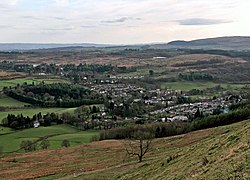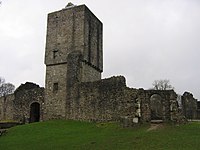Strathblane: Difference between revisions
Created page with "{{Infobox town |name=Strathblane |gaelic=Strath Bhlàthain |county=Stirlingshire |picture=Strathblane.jpg |picture caption=Over Strathblane from Ballagan |os grid ref=NS561794..." |
m clean up, typos fixed: of of → of |
||
| (One intermediate revision by one other user not shown) | |||
| Line 16: | Line 16: | ||
|constituency=Stirling | |constituency=Stirling | ||
}} | }} | ||
'''Strathblane''' is a village in [[Stirlingshire]], sitting beneath the foothills of the [[Campsie Fells]] and the [[Kilpatrick Hills]] on the Blane Water | '''Strathblane''' is a village and parish in [[Stirlingshire]], sitting beneath the foothills of the [[Campsie Fells]] and the [[Kilpatrick Hills]] on the Blane Water. It lies twelve miles north of [[Glasgow]] and fully twenty south-west of [[Stirling]]. Strathblane has become a commuter village for 'Greater Glasgow', and has a total resident population of 1,811. | ||
The wider parish comprises three villages: Edenkill, Netherton and Mugdock. Mugdock was the ancient seat of the Earls of Lennox,<ref>{{cite book|title=Four Ancient Books of Wales |last=Skene|first=William Forbes|authorlink=William Forbes Skene|publisher=Forgotten Books|year=2007|isbn=978-1-60506-165-8|page=118}}</ref> and indeed to the east of Strathblane lies the town of [[Lennoxtown]]. | |||
Blanefield is a settlement contiguous with Strathblane's northwestern fringe. To the west is the volcanic plug [[Dumgoyne]], Glengoyne Distillery and the [[Loch Lomond and the Trossachs]] National Park. The [[West Highland Way]]—a long-distance trail—passes close to the village. | Blanefield is a settlement contiguous with Strathblane's northwestern fringe. To the west is the volcanic plug [[Dumgoyne]], Glengoyne Distillery and the [[Loch Lomond and the Trossachs]] National Park. The [[West Highland Way]]—a long-distance trail—passes close to the village. | ||
| Line 32: | Line 32: | ||
===The Edmonstones of Duntreath=== | ===The Edmonstones of Duntreath=== | ||
The principal local family were the Edmonstones of [[Duntreath]] who had ancient kinship to the Kings of Scotland. In 1374 Sir John Edmonstone was an ambassador to France for King Robert II, subsequently his son Sir Archibald Edmonstone settled the family at Duntreath. In 1425, Sir Archibald's son Sir William Edmondstone of Culloden married Mary Stewart, Princess of Scotland (second daughter of Robert III) and they had a son whom they named Sir William Edmonstone of Duntreath.<ref>{{cite web|title=Genealogical account of the family of Edmonstone of Duntreath | The principal local family were the Edmonstones of [[Duntreath]] who had ancient kinship to the Kings of Scotland. In 1374 Sir John Edmonstone was an ambassador to France for King Robert II, subsequently his son Sir Archibald Edmonstone settled the family at Duntreath. In 1425, Sir Archibald's son Sir William Edmondstone of Culloden married Mary Stewart, Princess of Scotland (second daughter of Robert III) and they had a son whom they named Sir William Edmonstone of Duntreath.<ref>{{cite web|title=Genealogical account of the family of Edmonstone of Duntreath|url=http://archive.org/stream/genealogicalacco00inedmo/genealogicalacco00inedmo_djvu.txt|publisher=archive.org/|accessdate=21 February 2015}}</ref><ref>{{cite web|title=Lady Mary Stewart|url=http://www.thepeerage.com/p10533.htm|publisher=The Peerage|accessdate=21 February 2015}}</ref> More recently Edward VII's mistress Alice Keppel (née Alice Frederica Edmonstone) was the eighth daughter of the 4th Baronet (and is the great-grandmother of Camilla, Duchess of Cornwall, the wife of Charles Prince of Wales). | ||
{{clear}} | {{clear}} | ||
[[File:Strathblanepanorama2.jpg|center|thumb|900px|Wide view | [[File:Strathblanepanorama2.jpg|center|thumb|900px|Wide view of Strathblane from the rocky ridge leading to Earl's Seat]] | ||
{{clear}} | {{clear}} | ||
==Economy== | ==Economy== | ||
Latest revision as of 22:36, 28 January 2016
| Strathblane Gaelic: Strath Bhlàthain | |
| Stirlingshire | |
|---|---|
 Over Strathblane from Ballagan | |
| Location | |
| Grid reference: | NS561794 |
| Location: | 55°59’10"N, 4°18’22"W |
| Data | |
| Population: | 1,811 (2001) |
| Post town: | Glasgow |
| Postcode: | G63 |
| Dialling code: | 01360 |
| Local Government | |
| Council: | Stirling |
| Parliamentary constituency: |
Stirling |
Strathblane is a village and parish in Stirlingshire, sitting beneath the foothills of the Campsie Fells and the Kilpatrick Hills on the Blane Water. It lies twelve miles north of Glasgow and fully twenty south-west of Stirling. Strathblane has become a commuter village for 'Greater Glasgow', and has a total resident population of 1,811.
The wider parish comprises three villages: Edenkill, Netherton and Mugdock. Mugdock was the ancient seat of the Earls of Lennox,[1] and indeed to the east of Strathblane lies the town of Lennoxtown.
Blanefield is a settlement contiguous with Strathblane's northwestern fringe. To the west is the volcanic plug Dumgoyne, Glengoyne Distillery and the Loch Lomond and the Trossachs National Park. The West Highland Way—a long-distance trail—passes close to the village.
The village is named from the Blane Water, a river. The Blane Water may takes is name from the Gaelic Beul-abhainn meaning "mouth-river" after the numerous burns merging. One of its tributaries, the Ballagan Burn passes over the waterfall the Spout of Ballagan which shows 192 alternating strata of coloured shales and limestone (including pure alabaster).
The Blane flows into the River Endrick, which, in its turn, flows westward to Loch Lomond.
History
Historian William Forbes Skene suggested Strathblane to have been the site of the battle between the Britons and Picts in the year 750, during which Talorgan son of Fergus, brother of Óengus I of the Picts, was slain. The Annales Cambriae and Annals of Ulster refer to the battlefield as "Mocetauc" or "Catohic" respectively, which Skene and others have suggested referred to Mugdock, a locality at the edge of Lennox, within the parish of Strathblane.[2]
A rise in population during the early 19th century was due in part to the development of a large calico printfield at Blanefield (employing 78 adults and 45 children under 14) and two bleachfields at Dumbrock (employing 67 adults and 14 children under 14) working 10–11 hours per day, 6 days a week. There is no sign of this industry in the village today which has a rural, picturesque aspect while the majority of parishioners now commute to work in neighbouring towns.
The Edmonstones of Duntreath
The principal local family were the Edmonstones of Duntreath who had ancient kinship to the Kings of Scotland. In 1374 Sir John Edmonstone was an ambassador to France for King Robert II, subsequently his son Sir Archibald Edmonstone settled the family at Duntreath. In 1425, Sir Archibald's son Sir William Edmondstone of Culloden married Mary Stewart, Princess of Scotland (second daughter of Robert III) and they had a son whom they named Sir William Edmonstone of Duntreath.[3][4] More recently Edward VII's mistress Alice Keppel (née Alice Frederica Edmonstone) was the eighth daughter of the 4th Baronet (and is the great-grandmother of Camilla, Duchess of Cornwall, the wife of Charles Prince of Wales).

Economy
Tourism plays a prominent economic role in Strathblane. Tourists visit the area for the walks and the local scenery of the moors. There are local amenities in Strathblane, including post office, library, grocery shop, hairdressers, chemist, deli, pub and hotel, to name a few. There was a bank in Strathblane, but in 2014 it closed down.
The parish was formerly connected to Glasgow by way of Edinburgh and Glasgow Railway and the Blane Valley Railway, with stations at Campsie Glen, Strathblane,[5] Blanefield,[6] Dumgoyne and Killearn, which opened in 1867 (extended to Aberfoyle in 1882). However, the line became uncompetitive with the growth of road transport, and closed to passengers in 1951 and to freight in 1959.
Church
Strathblane Parish Church (Church of Scotland) belongs to the Presbytery of Stirling].[7] There is also a Roman Catholic church.
Sights about the village

Mugdock Castle was the stronghold of the Clan Graham from the middle of the 13th century. Its ruins are located in Mugdock Country Park at Strathblane's southern extremity with Milngavie.
The Stirling Observer dated 25 August 1921 reported the unveiling of "a monument erected in memory of those ..[25 men of Strathblane]... who fell in the Great War" by the Duke of Montrose and Sir Archibald Edmonstone, whose family seat was Duntreath Castle by Blanefield.[8] The monument is of Doddington stone, a square base, each side being panelled to receive the inscriptions and names, and a "slender shaft" rises from the base, at whose top are four shields, and headed with a cross.
The Duke of Montrose in unveiling the monument paid tribute to the sacrifice made by those from the parish who had died for their country. He said "what the war had meant to those who took part in it, and what their sacrifice meant to those who had benefited by their death, and what it ought to mean to the people of our land as an incentive to noble and self sacrificing lives."[9]
Sport
- Football: Blanefield Thistle FC
There are aldo clubs and organisations for bowls, darts, karate, snooker and bowls.[10]
See also
Outside links
| ("Wikimedia Commons" has material about Strathblane) |
References
- ↑ Skene, William Forbes (2007). Four Ancient Books of Wales. Forgotten Books. p. 118. ISBN 978-1-60506-165-8.
- ↑ Stringer, Keith (1998). Alexander, Grant. ed. Mediæval Scotland. Columbia University Press. p. 10. ISBN 978-0-7486-1110-2.
- ↑ "Genealogical account of the family of Edmonstone of Duntreath". archive.org/. http://archive.org/stream/genealogicalacco00inedmo/genealogicalacco00inedmo_djvu.txt. Retrieved 21 February 2015.
- ↑ "Lady Mary Stewart". The Peerage. http://www.thepeerage.com/p10533.htm. Retrieved 21 February 2015.
- ↑ Alison Dryden, Strathblane Station, Strathblane Historical Society, 2004
- ↑ Alison Dryden, Blanefield Station, Strathblane Historical Society, 2004
- ↑ "strathblaneparishchurch". http://www.strathblanefield.org.uk/organisations/strathblaneparishchurch.html.
- ↑ Mary McGrigor (1996). "The Family: Edmonstone of Duntreath". edmonstone.com. http://www.edmonstone.com/.
- ↑ "The First World War". http://www.strathblanefield.org.uk/history/FirstWorldWar.html.
- ↑ "Strathblane and Blanefield Organisations". http://www.strathblanefield.org.uk/organisations/organisations.html.
